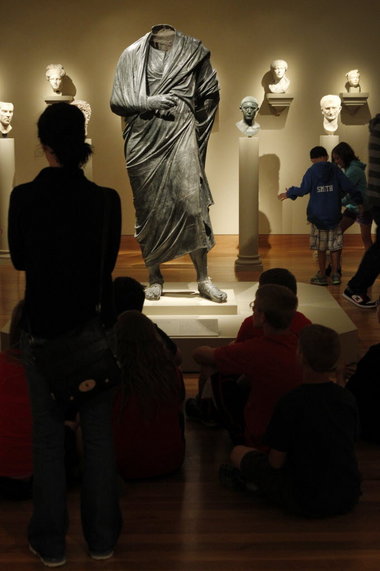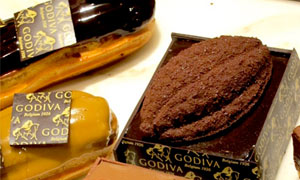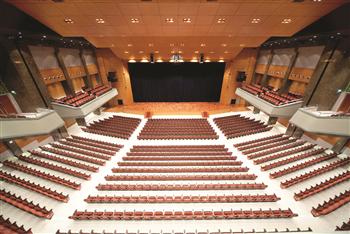
A large, headless, Roman-era bronze statue believed to represent Marcus Aurelius has reigned for 26 years as the resident philosopher-king of the Cleveland Museum of Art. With its lifelike presence, fluid drapery folds and dark, luscious patina, the sculpture is one of the museum’s signature treasures. Yet a mystery has always hovered over this exceedingly rare object. Where, exactly, did it come out of the ground, and who unearthed it?
Just as important, how many hands did it pass through before it found its way into the collection in 1986? The museum has long stated that the work might have been found in the 1960s in an obscure village in southwestern Turkey called Bubon, but it isn't sure.
The government of Turkey, on the other hand, is sure. It says that the bronze and nearly two dozen other works in Cleveland were looted from its soil, although the country has produced no evidence.
According to reports in the Los Angeles Times, Newsweek and Britain's Economist, the country has launched an international campaign aimed at repatriating such works. And it's proceeding in a way that could shake the foundations of encyclopedic museums with items collected before contemporary laws and international agreements intended to prevent looting and trafficking.
 TCA is hosting the National Association of Attorneys General (NAAG) and Attorneys General from four states this week on a program that takes the delegation to Istanbul, Patara and Ankara. The tour is led by Doug Gansler of Maryland and includes David M. Louie of Hawaii, Lawrence G. Wasden of Idaho and Chris Koster of Missouri. The delegation met with Turkish President Abdullah Gul in Istanbul and will also be visiting the President of the Turkish Constitutional Court, members of the Turkish Parliament, as well as leading journalists, legal and foreign policy experts.
TCA is hosting the National Association of Attorneys General (NAAG) and Attorneys General from four states this week on a program that takes the delegation to Istanbul, Patara and Ankara. The tour is led by Doug Gansler of Maryland and includes David M. Louie of Hawaii, Lawrence G. Wasden of Idaho and Chris Koster of Missouri. The delegation met with Turkish President Abdullah Gul in Istanbul and will also be visiting the President of the Turkish Constitutional Court, members of the Turkish Parliament, as well as leading journalists, legal and foreign policy experts.

 Intel Capital is the first Silicon Valley investor to launch an office in Turkey's largest city, Istanbul, reports Financial News. Intel Capital is an American multinational company that makes investments in innovative technology start-ups as well as in firms offering hardware, software and services. The company has been investing in Turkey since 2005 and sees that the country has large potential as it has many technology innovators and entrepreneurs. Intel Capital most recent investments in Turkey are to Turkish companies Nokta and Grupanya.
Intel Capital is the first Silicon Valley investor to launch an office in Turkey's largest city, Istanbul, reports Financial News. Intel Capital is an American multinational company that makes investments in innovative technology start-ups as well as in firms offering hardware, software and services. The company has been investing in Turkey since 2005 and sees that the country has large potential as it has many technology innovators and entrepreneurs. Intel Capital most recent investments in Turkey are to Turkish companies Nokta and Grupanya. ScienceDaily (June 5, 2012) — Sierra Nevada Corporation (SNC) Space Systems' Dream Chaser design passed one of its most complex tests to date with a successful captive-carry test conducted near the Rocky Mountain Metropolitan Airport in Jefferson County, Colo., on May 29. Just like the space shuttle before it, SNC's Dream Chaser will go through extensive testing to prove its wings will work. The company built a full-scale flight vehicle of the Dream Chaser spacecraft to carry out the evaluations.
ScienceDaily (June 5, 2012) — Sierra Nevada Corporation (SNC) Space Systems' Dream Chaser design passed one of its most complex tests to date with a successful captive-carry test conducted near the Rocky Mountain Metropolitan Airport in Jefferson County, Colo., on May 29. Just like the space shuttle before it, SNC's Dream Chaser will go through extensive testing to prove its wings will work. The company built a full-scale flight vehicle of the Dream Chaser spacecraft to carry out the evaluations. If you had to pick a company as a metaphor for the key themes of this year’s World Economic Forum, you’d be pressed to find a better example than Turkey’s Yildiz Holding. The Istanbul conference — themed “bridging transformations,” and which opened Tuesday — is the first WEF meeting to focus specifically on the Middle East, Africa and Eurasia regions. It’s a region that Yildiz, an Istanbul-based food and beverages conglomerate that owns sweets maker Ulker and the luxury chocolate brand, Godiva, knows all to well. Propelled by a strong domestic market and rapid expansion across markets from West Africa to South Asia, the company, which posted an average of 11% revenue growth over the past two years and forecasts an expansion of 14% this year, is one of fast-growing Turkey’s corporate success stories.
If you had to pick a company as a metaphor for the key themes of this year’s World Economic Forum, you’d be pressed to find a better example than Turkey’s Yildiz Holding. The Istanbul conference — themed “bridging transformations,” and which opened Tuesday — is the first WEF meeting to focus specifically on the Middle East, Africa and Eurasia regions. It’s a region that Yildiz, an Istanbul-based food and beverages conglomerate that owns sweets maker Ulker and the luxury chocolate brand, Godiva, knows all to well. Propelled by a strong domestic market and rapid expansion across markets from West Africa to South Asia, the company, which posted an average of 11% revenue growth over the past two years and forecasts an expansion of 14% this year, is one of fast-growing Turkey’s corporate success stories. "NY Med," an eight-episode documentary series follow-up to "Boston Med" and "Hopkins," is heading to ABC this July. The new documentary series will explore the lives of doctors and patients inside of Columbia and Weill Cornell hospitals, two of New York's most prestigious hospitals.
"NY Med," an eight-episode documentary series follow-up to "Boston Med" and "Hopkins," is heading to ABC this July. The new documentary series will explore the lives of doctors and patients inside of Columbia and Weill Cornell hospitals, two of New York's most prestigious hospitals.  By JASON GOODWIN - NYT - Joseph Kanon is a specialist in fin de guerre thrillers, whose previous novels set in 1945-46 include “Alibi,” “Los Alamos,” “The Good German” and “Stardust.” The period is well chosen: dark secrets are finally coming to the surface, and people are being called to account for what the war has made them. For readers, it’s immediately recognizable territory: the aftermath of the conflict, shabby, filmic. Now, in “Istanbul Passage,” Kanon compounds the fraught postwar mood with a location to match.
By JASON GOODWIN - NYT - Joseph Kanon is a specialist in fin de guerre thrillers, whose previous novels set in 1945-46 include “Alibi,” “Los Alamos,” “The Good German” and “Stardust.” The period is well chosen: dark secrets are finally coming to the surface, and people are being called to account for what the war has made them. For readers, it’s immediately recognizable territory: the aftermath of the conflict, shabby, filmic. Now, in “Istanbul Passage,” Kanon compounds the fraught postwar mood with a location to match. A Turkish mill booked a 30,000 mt mixed cargo from a North American supplier at a composite price of $403/mt CFR Izmir late Thursday, revealing the level of the global import benchmark market. The cargo includes 12,000 mt of plate and structural, 12,000 mt of shredded scrap and 6,000 mt of HMS I. Platts daily assessment has now lost $50/mt in a month, starting June at $400/mt CFR Turkish ports for premium-graded heavy melting scrap I/II (80/20 blend): a decrease of $10/mt in a day. This is the lowest point the price series has been since records began in December 2010. The reduction month-on-month matches almost to the dollar the decrease heard in the US domestic market for June.
A Turkish mill booked a 30,000 mt mixed cargo from a North American supplier at a composite price of $403/mt CFR Izmir late Thursday, revealing the level of the global import benchmark market. The cargo includes 12,000 mt of plate and structural, 12,000 mt of shredded scrap and 6,000 mt of HMS I. Platts daily assessment has now lost $50/mt in a month, starting June at $400/mt CFR Turkish ports for premium-graded heavy melting scrap I/II (80/20 blend): a decrease of $10/mt in a day. This is the lowest point the price series has been since records began in December 2010. The reduction month-on-month matches almost to the dollar the decrease heard in the US domestic market for June. Vision Solutions, Inc., the world's leading provider of information availability software and services, today announced their partnership with Istanbul Pazarlama A.S., one of the oldest and most established companies in Turkey's IT sector. The partnership comes on the heels of headlines that report Turkey is becoming the fastest growing economy in the world. From 2002 to 2010 the Turkish GDP grew from $230 billion to $736 billion. Turkish GDP grew by 8.9 percent in 2010 and its estimated growth will continue at this rate. Optimism for growth in the IT sector remains high due to youthful, well-educated and technically savvy population -- half the entire country is under the age of 29.
Vision Solutions, Inc., the world's leading provider of information availability software and services, today announced their partnership with Istanbul Pazarlama A.S., one of the oldest and most established companies in Turkey's IT sector. The partnership comes on the heels of headlines that report Turkey is becoming the fastest growing economy in the world. From 2002 to 2010 the Turkish GDP grew from $230 billion to $736 billion. Turkish GDP grew by 8.9 percent in 2010 and its estimated growth will continue at this rate. Optimism for growth in the IT sector remains high due to youthful, well-educated and technically savvy population -- half the entire country is under the age of 29. Spellbinding but worrisome from a logistical standpoint, dark horse Istanbul's bid to host the 2020 Olympics eerily echoes Rio de Janeiro's footing when it came from behind to win the right to host the 2016 Games. Four years ago, Rio, in a major upset, became the first nation in South America to secure the Games, despite a technical score well below rivals Tokyo and Chicago going into the final vote.
Spellbinding but worrisome from a logistical standpoint, dark horse Istanbul's bid to host the 2020 Olympics eerily echoes Rio de Janeiro's footing when it came from behind to win the right to host the 2016 Games. Four years ago, Rio, in a major upset, became the first nation in South America to secure the Games, despite a technical score well below rivals Tokyo and Chicago going into the final vote.  Istanbul retained its place on the list of the top 10 convention destinations centers in the world last year, the Istanbul Chamber of Commerce (İTO) said yesterday. Istanbul was in seventh place in 2010 with 109 conventions, but fell to ninth place in 2011, although the number of conferences held in the city rose to 113, according to data from the International Congress and Convention Association.
Istanbul retained its place on the list of the top 10 convention destinations centers in the world last year, the Istanbul Chamber of Commerce (İTO) said yesterday. Istanbul was in seventh place in 2010 with 109 conventions, but fell to ninth place in 2011, although the number of conferences held in the city rose to 113, according to data from the International Congress and Convention Association.  A large, headless, Roman-era bronze statue believed to represent Marcus Aurelius has reigned for 26 years as the resident philosopher-king of the Cleveland Museum of Art. With its lifelike presence, fluid drapery folds and dark, luscious patina, the sculpture is one of the museum’s signature treasures. Yet a mystery has always hovered over this exceedingly rare object. Where, exactly, did it come out of the ground, and who unearthed it?
A large, headless, Roman-era bronze statue believed to represent Marcus Aurelius has reigned for 26 years as the resident philosopher-king of the Cleveland Museum of Art. With its lifelike presence, fluid drapery folds and dark, luscious patina, the sculpture is one of the museum’s signature treasures. Yet a mystery has always hovered over this exceedingly rare object. Where, exactly, did it come out of the ground, and who unearthed it? Huntsville, Alabama is now home to one of America's fastest growing private companies, and the top Woman-Owned Federal Contractor in the United States. Sierra Nevada Corporation (SNC), headquartered in Sparks, Nev., announced today at a reception for Huntsville business and community leaders at the U.S. Space & Rocket Center, that the company has opened an office at 1525 Perimeter Parkway, in Huntsville.
Huntsville, Alabama is now home to one of America's fastest growing private companies, and the top Woman-Owned Federal Contractor in the United States. Sierra Nevada Corporation (SNC), headquartered in Sparks, Nev., announced today at a reception for Huntsville business and community leaders at the U.S. Space & Rocket Center, that the company has opened an office at 1525 Perimeter Parkway, in Huntsville.






